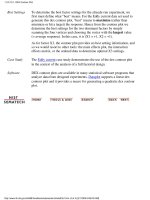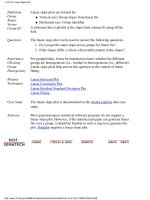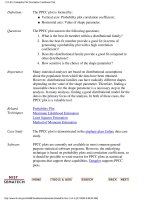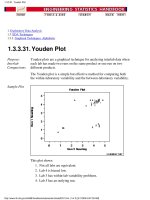Engineering Statistics Handbook Episode 1 Part 12 doc
Bạn đang xem bản rút gọn của tài liệu. Xem và tải ngay bản đầy đủ của tài liệu tại đây (109.91 KB, 19 trang )
1. Exploratory Data Analysis
1.3. EDA Techniques
1.3.5. Quantitative Techniques
1.3.5.6.Measures of Scale
Scale,
Variability, or
Spread
A fundamental task in many statistical analyses is to characterize the
spread, or variability, of a data set. Measures of scale are simply
attempts to estimate this variability.
When assessing the variability of a data set, there are two key
components:
How spread out are the data values near the center?1.
How spread out are the tails?2.
Different numerical summaries will give different weight to these two
elements. The choice of scale estimator is often driven by which of
these components you want to emphasize.
The histogram is an effective graphical technique for showing both of
these components of the spread.
Definitions of
Variability
For univariate data, there are several common numerical measures of
the spread:
variance - the variance is defined as
where is the mean of the data.
The variance is roughly the arithmetic average of the squared
distance from the mean. Squaring the distance from the mean
has the effect of giving greater weight to values that are further
from the mean. For example, a point 2 units from the mean
adds 4 to the above sum while a point 10 units from the mean
adds 100 to the sum. Although the variance is intended to be an
overall measure of spread, it can be greatly affected by the tail
behavior.
1.
standard deviation - the standard deviation is the square root of
the variance. That is,
2.
1.3.5.6. Measures of Scale
(1 of 6) [5/1/2006 9:57:16 AM]
The standard deviation restores the units of the spread to the
original data units (the variance squares the units).
range - the range is the largest value minus the smallest value in
a data set. Note that this measure is based only on the lowest
and highest extreme values in the sample. The spread near the
center of the data is not captured at all.
3.
average absolute deviation - the average absolute deviation
(AAD) is defined as
where is the mean of the data and |Y| is the absolute value of
Y. This measure does not square the distance from the mean, so
it is less affected by extreme observations than are the variance
and standard deviation.
4.
median absolute deviation - the median absolute deviation
(MAD) is defined as
where is the median of the data and |Y| is the absolute value
of Y. This is a variation of the average absolute deviation that is
even less affected by extremes in the tail because the data in the
tails have less influence on the calculation of the median than
they do on the mean.
5.
interquartile range - this is the value of the 75th percentile
minus the value of the 25th percentile. This measure of scale
attempts to measure the variability of points near the center.
6.
In summary, the variance, standard deviation, average absolute
deviation, and median absolute deviation measure both aspects of the
variability; that is, the variability near the center and the variability in
the tails. They differ in that the average absolute deviation and median
absolute deviation do not give undue weight to the tail behavior. On
the other hand, the range only uses the two most extreme points and
the interquartile range only uses the middle portion of the data.
1.3.5.6. Measures of Scale
(2 of 6) [5/1/2006 9:57:16 AM]
Why Different
Measures?
The following example helps to clarify why these alternative
defintions of spread are useful and necessary.
This plot shows histograms for 10,000 random numbers generated
from a normal, a double exponential, a Cauchy, and a Tukey-Lambda
distribution.
Normal
Distribution
The first histogram is a sample from a normal distribution. The
standard deviation is 0.997, the median absolute deviation is 0.681,
and the range is 7.87.
The normal distribution is a symmetric distribution with well-behaved
tails and a single peak at the center of the distribution. By symmetric,
we mean that the distribution can be folded about an axis so that the
two sides coincide. That is, it behaves the same to the left and right of
some center point. In this case, the median absolute deviation is a bit
less than the standard deviation due to the downweighting of the tails.
The range of a little less than 8 indicates the extreme values fall
within about 4 standard deviations of the mean. If a histogram or
normal probability plot indicates that your data are approximated well
by a normal distribution, then it is reasonable to use the standard
deviation as the spread estimator.
1.3.5.6. Measures of Scale
(3 of 6) [5/1/2006 9:57:16 AM]
Double
Exponential
Distribution
The second histogram is a sample from a double exponential
distribution. The standard deviation is 1.417, the median absolute
deviation is 0.706, and the range is 17.556.
Comparing the double exponential and the normal histograms shows
that the double exponential has a stronger peak at the center, decays
more rapidly near the center, and has much longer tails. Due to the
longer tails, the standard deviation tends to be inflated compared to
the normal. On the other hand, the median absolute deviation is only
slightly larger than it is for the normal data. The longer tails are
clearly reflected in the value of the range, which shows that the
extremes fall about 12 standard deviations from the mean compared to
about 4 for the normal data.
Cauchy
Distribution
The third histogram is a sample from a Cauchy distribution. The
standard deviation is 998.389, the median absolute deviation is 1.16,
and the range is 118,953.6.
The Cauchy distribution is a symmetric distribution with heavy tails
and a single peak at the center of the distribution. The Cauchy
distribution has the interesting property that collecting more data does
not provide a more accurate estimate for the mean or standard
deviation. That is, the sampling distribution of the means and standard
deviation are equivalent to the sampling distribution of the original
data. That means that for the Cauchy distribution the standard
deviation is useless as a measure of the spread. From the histogram, it
is clear that just about all the data are between about -5 and 5.
However, a few very extreme values cause both the standard deviation
and range to be extremely large. However, the median absolute
deviation is only slightly larger than it is for the normal distribution.
In this case, the median absolute deviation is clearly the better
measure of spread.
Although the Cauchy distribution is an extreme case, it does illustrate
the importance of heavy tails in measuring the spread. Extreme values
in the tails can distort the standard deviation. However, these extreme
values do not distort the median absolute deviation since the median
absolute deviation is based on ranks. In general, for data with extreme
values in the tails, the median absolute deviation or interquartile range
can provide a more stable estimate of spread than the standard
deviation.
1.3.5.6. Measures of Scale
(4 of 6) [5/1/2006 9:57:16 AM]
Tukey-Lambda
Distribution
The fourth histogram is a sample from a Tukey lambda distribution
with shape parameter
= 1.2. The standard deviation is 0.49, the
median absolute deviation is 0.427, and the range is 1.666.
The Tukey lambda distribution has a range limited to .
That is, it has truncated tails. In this case the standard deviation and
median absolute deviation have closer values than for the other three
examples which have significant tails.
Robustness
Tukey and Mosteller defined two types of robustness where
robustness is a lack of susceptibility to the effects of nonnormality.
Robustness of validity means that the confidence intervals for a
measure of the population spread (e.g., the standard deviation)
have a 95% chance of covering the true value (i.e., the
population value) of that measure of spread regardless of the
underlying distribution.
1.
Robustness of efficiency refers to high effectiveness in the face
of non-normal tails. That is, confidence intervals for the
measure of spread tend to be almost as narrow as the best that
could be done if we knew the true shape of the distribution.
2.
The standard deviation is an example of an estimator that is the best
we can do if the underlying distribution is normal. However, it lacks
robustness of validity. That is, confidence intervals based on the
standard deviation tend to lack precision if the underlying distribution
is in fact not normal.
The median absolute deviation and the interquartile range are
estimates of scale that have robustness of validity. However, they are
not particularly strong for robustness of efficiency.
If histograms and probability plots indicate that your data are in fact
reasonably approximated by a normal distribution, then it makes sense
to use the standard deviation as the estimate of scale. However, if your
data are not normal, and in particular if there are long tails, then using
an alternative measure such as the median absolute deviation, average
absolute deviation, or interquartile range makes sense. The range is
used in some applications, such as quality control, for its simplicity. In
addition, comparing the range to the standard deviation gives an
indication of the spread of the data in the tails.
Since the range is determined by the two most extreme points in the
data set, we should be cautious about its use for large values of N.
Tukey and Mosteller give a scale estimator that has both robustness of
1.3.5.6. Measures of Scale
(5 of 6) [5/1/2006 9:57:16 AM]
validity and robustness of efficiency. However, it is more complicated
and we do not give the formula here.
Software Most general purpose statistical software programs, including
Dataplot, can generate at least some of the measures of scale
discusssed above.
1.3.5.6. Measures of Scale
(6 of 6) [5/1/2006 9:57:16 AM]
Critical
Region:
The variances are judged to be unequal if,
where is the upper critical value of the chi-square distribution
with k - 1 degrees of freedom and a significance level of
.
In the above formulas for the critical regions, the Handbook follows the
convention that
is the upper critical value from the chi-square
distribution and
is the lower critical value from the chi-square
distribution. Note that this is the opposite of some texts and software
programs. In particular, Dataplot uses the opposite convention.
An alternate definition (Dixon and Massey, 1969) is based on an approximation to the F
distribution. This definition is given in the Product and Process Comparisons chapter
(chapter 7).
Sample
Output
Dataplot generated the following output for Bartlett's test using the GEAR.DAT
data set:
BARTLETT TEST
(STANDARD DEFINITION)
NULL HYPOTHESIS UNDER TEST ALL SIGMA(I) ARE EQUAL
TEST:
DEGREES OF FREEDOM = 9.000000
TEST STATISTIC VALUE = 20.78580
CUTOFF: 95% PERCENT POINT = 16.91898
CUTOFF: 99% PERCENT POINT = 21.66600
CHI-SQUARE CDF VALUE = 0.986364
NULL NULL HYPOTHESIS NULL HYPOTHESIS
HYPOTHESIS ACCEPTANCE INTERVAL CONCLUSION
ALL SIGMA EQUAL (0.000,0.950) REJECT
1.3.5.7. Bartlett's Test
(2 of 3) [5/1/2006 9:57:17 AM]
Interpretation
of Sample
Output
We are testing the hypothesis that the group variances are all equal.
The output is divided into two sections.
The first section prints the value of the Bartlett test statistic, the
degrees of freedom (k-1), the upper critical value of the
chi-square distribution corresponding to significance levels of
0.05 (the 95% percent point) and 0.01 (the 99% percent point).
We reject the null hypothesis at that significance level if the
value of the Bartlett test statistic is greater than the
corresponding critical value.
1.
The second section prints the conclusion for a 95% test.2.
Output from other statistical software may look somewhat different
from the above output.
Question Bartlett's test can be used to answer the following question:
Is the assumption of equal variances valid?
●
Importance Bartlett's test is useful whenever the assumption of equal variances is
made. In particular, this assumption is made for the frequently used
one-way analysis of variance. In this case, Bartlett's or Levene's test
should be applied to verify the assumption.
Related
Techniques
Standard Deviation Plot
Box Plot
Levene Test
Chi-Square Test
Analysis of Variance
Case Study
Heat flow meter data
Software The Bartlett test is available in many general purpose statistical
software programs, including Dataplot.
1.3.5.7. Bartlett's Test
(3 of 3) [5/1/2006 9:57:17 AM]
Critical Region: Reject the null hypothesis that the standard deviation is a
specified value,
, if
for an upper one-tailed alternative
for a lower one-tailed alternative
for a two-tailed test
or
where is the critical value of the chi-square
distribution with N - 1 degrees of freedom.
In the above formulas for the critical regions, the Handbook
follows the convention that
is the upper critical value
from the chi-square distribution and
is the lower
critical value from the chi-square distribution. Note that this
is the opposite of some texts and software programs. In
particular, Dataplot uses the opposite convention.
The formula for the hypothesis test can easily be converted to form an interval
estimate for the standard deviation:
Sample
Output
Dataplot generated the following output for a chi-square test from the
GEAR.DAT data set:
CHI-SQUARED TEST
SIGMA0 = 0.1000000
NULL HYPOTHESIS UNDER TEST STANDARD DEVIATION SIGMA =
.1000000
SAMPLE:
NUMBER OF OBSERVATIONS = 100
MEAN = 0.9976400
STANDARD DEVIATION S = 0.6278908E-02
TEST:
S/SIGMA0 = 0.6278908E-01
CHI-SQUARED STATISTIC = 0.3903044
1.3.5.8. Chi-Square Test for the Standard Deviation
(2 of 4) [5/1/2006 9:57:18 AM]
DEGREES OF FREEDOM = 99.00000
CHI-SQUARED CDF VALUE = 0.000000
ALTERNATIVE- ALTERNATIVE-
ALTERNATIVE- HYPOTHESIS HYPOTHESIS
HYPOTHESIS ACCEPTANCE INTERVAL CONCLUSION
SIGMA <> .1000000 (0,0.025), (0.975,1) ACCEPT
SIGMA < .1000000 (0,0.05) ACCEPT
SIGMA > .1000000 (0.95,1) REJECT
Interpretation
of Sample
Output
We are testing the hypothesis that the population standard deviation is 0.1. The
output is divided into three sections.
The first section prints the sample statistics used in the computation of the
chi-square test.
1.
The second section prints the chi-square test statistic value, the degrees of
freedom, and the cumulative distribution function (cdf) value of the
chi-square test statistic. The chi-square test statistic cdf value is an
alternative way of expressing the critical value. This cdf value is compared
to the acceptance intervals printed in section three. For an upper one-tailed
test, the alternative hypothesis acceptance interval is (1 -
,1), the
alternative hypothesis acceptance interval for a lower one-tailed test is (0,
), and the alternative hypothesis acceptance interval for a two-tailed test
is (1 -
/2,1) or (0, /2). Note that accepting the alternative hypothesis is
equivalent to rejecting the null hypothesis.
2.
The third section prints the conclusions for a 95% test since this is the most
common case. Results are given in terms of the alternative hypothesis for
the two-tailed test and for the one-tailed test in both directions. The
alternative hypothesis acceptance interval column is stated in terms of the
cdf value printed in section two. The last column specifies whether the
alternative hypothesis is accepted or rejected. For a different significance
level, the appropriate conclusion can be drawn from the chi-square test
statistic cdf value printed in section two. For example, for a significance
level of 0.10, the corresponding alternative hypothesis acceptance intervals
are (0,0.05) and (0.95,1), (0, 0.10), and (0.90,1).
3.
Output from other statistical software may look somewhat different from the
above output.
Questions The chi-square test can be used to answer the following questions:
Is the standard deviation equal to some pre-determined threshold value?1.
Is the standard deviation greater than some pre-determined threshold value?2.
Is the standard deviation less than some pre-determined threshold value?3.
1.3.5.8. Chi-Square Test for the Standard Deviation
(3 of 4) [5/1/2006 9:57:18 AM]
Related
Techniques
F Test
Bartlett Test
Levene Test
Software The chi-square test for the standard deviation is available in many general purpose
statistical software programs, including Dataplot.
1.3.5.8. Chi-Square Test for the Standard Deviation
(4 of 4) [5/1/2006 9:57:18 AM]
0.999 3.000
0.996 3.000
0.996 3.000
1.005 4.000
1.002 4.000
0.994 4.000
1.000 4.000
0.995 4.000
0.994 4.000
0.998 4.000
0.996 4.000
1.002 4.000
0.996 4.000
0.998 5.000
0.998 5.000
0.982 5.000
0.990 5.000
1.002 5.000
0.984 5.000
0.996 5.000
0.993 5.000
0.980 5.000
0.996 5.000
1.009 6.000
1.013 6.000
1.009 6.000
0.997 6.000
0.988 6.000
1.002 6.000
0.995 6.000
0.998 6.000
0.981 6.000
0.996 6.000
0.990 7.000
1.004 7.000
0.996 7.000
1.001 7.000
0.998 7.000
1.000 7.000
1.018 7.000
1.010 7.000
0.996 7.000
1.002 7.000
0.998 8.000
1.000 8.000
1.006 8.000
1.3.5.8.1. Data Used for Chi-Square Test for the Standard Deviation
(2 of 3) [5/1/2006 9:57:18 AM]
1.000 8.000
1.002 8.000
0.996 8.000
0.998 8.000
0.996 8.000
1.002 8.000
1.006 8.000
1.002 9.000
0.998 9.000
0.996 9.000
0.995 9.000
0.996 9.000
1.004 9.000
1.004 9.000
0.998 9.000
0.999 9.000
0.991 9.000
0.991 10.000
0.995 10.000
0.984 10.000
0.994 10.000
0.997 10.000
0.997 10.000
0.991 10.000
0.998 10.000
1.004 10.000
0.997 10.000
1.3.5.8.1. Data Used for Chi-Square Test for the Standard Deviation
(3 of 3) [5/1/2006 9:57:18 AM]
Critical
Region:
The hypothesis that the two standard deviations are equal is rejected if
for an upper one-tailed test
for a lower one-tailed test
for a two-tailed test
or
where is the critical value of the F distribution with and
degrees of freedom and a significance level of .
In the above formulas for the critical regions, the Handbook follows the
convention that
is the upper critical value from the F distribution and
is the lower critical value from the F distribution. Note that this is
the opposite of the designation used by some texts and software programs.
In particular, Dataplot uses the opposite convention.
Sample
Output
Dataplot generated the following output for an F-test from the JAHANMI2.DAT data
set:
F TEST
NULL HYPOTHESIS UNDER TEST SIGMA1 = SIGMA2
ALTERNATIVE HYPOTHESIS UNDER TEST SIGMA1 NOT EQUAL SIGMA2
SAMPLE 1:
NUMBER OF OBSERVATIONS = 240
MEAN = 688.9987
STANDARD DEVIATION = 65.54909
SAMPLE 2:
NUMBER OF OBSERVATIONS = 240
MEAN = 611.1559
STANDARD DEVIATION = 61.85425
TEST:
STANDARD DEV. (NUMERATOR) = 65.54909
STANDARD DEV. (DENOMINATOR) = 61.85425
F TEST STATISTIC VALUE = 1.123037
DEG. OF FREEDOM (NUMER.) = 239.0000
DEG. OF FREEDOM (DENOM.) = 239.0000
F TEST STATISTIC CDF VALUE = 0.814808
NULL NULL HYPOTHESIS NULL HYPOTHESIS
HYPOTHESIS ACCEPTANCE INTERVAL CONCLUSION
SIGMA1 = SIGMA2 (0.000,0.950) ACCEPT
1.3.5.9. F-Test for Equality of Two Standard Deviations
(2 of 3) [5/1/2006 9:57:19 AM]
Interpretation
of Sample
Output
We are testing the hypothesis that the standard deviations for sample one and sample
two are equal. The output is divided into four sections.
The first section prints the sample statistics for sample one used in the
computation of the F-test.
1.
The second section prints the sample statistics for sample two used in the
computation of the F-test.
2.
The third section prints the numerator and denominator standard deviations, the
F-test statistic value, the degrees of freedom, and the cumulative distribution
function (cdf) value of the F-test statistic. The F-test statistic cdf value is an
alternative way of expressing the critical value. This cdf value is compared to the
acceptance interval printed in section four. The acceptance interval for a
two-tailed test is (0,1 -
).
3.
The fourth section prints the conclusions for a 95% test since this is the most
common case. Results are printed for an upper one-tailed test. The acceptance
interval column is stated in terms of the cdf value printed in section three. The
last column specifies whether the null hypothesis is accepted or rejected. For a
different significance level, the appropriate conclusion can be drawn from the
F-test statistic cdf value printed in section four. For example, for a significance
level of 0.10, the corresponding acceptance interval become (0.000,0.9000).
4.
Output from other statistical software may look somewhat different from the above
output.
Questions The F-test can be used to answer the following questions:
Do two samples come from populations with equal standard deviations?1.
Does a new process, treatment, or test reduce the variability of the current
process?
2.
Related
Techniques
Quantile-Quantile Plot
Bihistogram
Chi-Square Test
Bartlett's Test
Levene Test
Case Study
Ceramic strength data.
Software The F-test for equality of two standard deviations is available in many general purpose
statistical software programs, including Dataplot.
1.3.5.9. F-Test for Equality of Two Standard Deviations
(3 of 3) [5/1/2006 9:57:19 AM]
where is the 10% trimmed mean of the ith
subgroup.
3.
are the group means of the Z
ij
and is the overall
mean of the Z
ij
.
The three choices for defining Z
ij
determine the robustness
and power of Levene's test. By robustness, we mean the
ability of the test to not falsely detect unequal variances
when the underlying data are not normally distributed and
the variables are in fact equal. By power, we mean the
ability of the test to detect unequal variances when the
variances are in fact unequal.
Levene's original paper only proposed using the mean.
Brown and Forsythe (1974)) extended Levene's test to use
either the median or the trimmed mean in addition to the
mean. They performed Monte Carlo studies that indicated
that using the trimmed mean performed best when the
underlying data followed a Cauchy distribution (i.e.,
heavy-tailed) and the median performed best when the
underlying data followed a
(i.e., skewed) distribution.
Using the mean provided the best power for symmetric,
moderate-tailed, distributions.
Although the optimal choice depends on the underlying
distribution, the definition based on the median is
recommended as the choice that provides good robustness
against many types of non-normal data while retaining
good power. If you have knowledge of the underlying
distribution of the data, this may indicate using one of the
other choices.
Significance
Level:
1.3.5.10. Levene Test for Equality of Variances
(2 of 4) [5/1/2006 9:57:20 AM]
Critical
Region:
The Levene test rejects the hypothesis that the variances are
equal if
where is the upper critical value of the F
distribution with k - 1 and N - k degrees of freedom at a
significance level of
.
In the above formulas for the critical regions, the Handbook
follows the convention that
is the upper critical value
from the F distribution and
is the lower critical
value. Note that this is the opposite of some texts and
software programs. In particular, Dataplot uses the opposite
convention.
Sample
Output
Dataplot generated the following output for Levene's test using the
GEAR.DAT data set (by default, Dataplot performs the form of the test
based on the median):
LEVENE F-TEST FOR SHIFT IN VARIATION
(CASE: TEST BASED ON MEDIANS)
1. STATISTICS
NUMBER OF OBSERVATIONS = 100
NUMBER OF GROUPS = 10
LEVENE F TEST STATISTIC = 1.705910
2. FOR LEVENE TEST STATISTIC
0 % POINT = 0.
50 % POINT = 0.9339308
75 % POINT = 1.296365
90 % POINT = 1.702053
95 % POINT = 1.985595
99 % POINT = 2.610880
99.9 % POINT = 3.478882
90.09152 % Point: 1.705910
3. CONCLUSION (AT THE 5% LEVEL):
THERE IS NO SHIFT IN VARIATION.
THUS: HOMOGENEOUS WITH RESPECT TO VARIATION.
1.3.5.10. Levene Test for Equality of Variances
(3 of 4) [5/1/2006 9:57:20 AM]
Interpretation
of Sample
Output
We are testing the hypothesis that the group variances are equal. The
output is divided into three sections.
The first section prints the number of observations (N), the number
of groups (k), and the value of the Levene test statistic.
1.
The second section prints the upper critical value of the F
distribution corresponding to various significance levels. The value
in the first column, the confidence level of the test, is equivalent to
100(1-
). We reject the null hypothesis at that significance level if
the value of the Levene F test statistic printed in section one is
greater than the critical value printed in the last column.
2.
The third section prints the conclusion for a 95% test. For a
different significance level, the appropriate conclusion can be drawn
from the table printed in section two. For example, for
= 0.10, we
look at the row for 90% confidence and compare the critical value
1.702 to the Levene test statistic 1.7059. Since the test statistic is
greater than the critical value, we reject the null hypothesis at the
= 0.10 level.
3.
Output from other statistical software may look somewhat different from
the above output.
Question Levene's test can be used to answer the following question:
Is the assumption of equal variances valid?
●
Related
Techniques
Standard Deviation Plot
Box Plot
Bartlett Test
Chi-Square Test
Analysis of Variance
Software The Levene test is available in some general purpose statistical software
programs, including Dataplot.
1.3.5.10. Levene Test for Equality of Variances
(4 of 4) [5/1/2006 9:57:20 AM]
Definition of
Kurtosis
For univariate data Y
1
, Y
2
, , Y
N
, the formula for kurtosis is:
where is the mean, is the standard deviation, and N is the number of
data points.
The kurtosis for a standard normal distribution is three. For this reason,
excess kurtosis is defined as
so that the standard normal distribution has a kurtosis of zero. Positive
kurtosis indicates a "peaked" distribution and negative kurtosis indicates
a "flat" distribution.
Examples The following example shows histograms for 10,000 random numbers
generated from a normal, a double exponential, a Cauchy, and a Weibull
distribution.
Normal
Distribution
The first histogram is a sample from a normal distribution. The normal
distribution is a symmetric distribution with well-behaved tails. This is
indicated by the skewness of 0.03. The kurtosis of 2.96 is near the
expected value of 3. The histogram verifies the symmetry.
1.3.5.11. Measures of Skewness and Kurtosis
(2 of 4) [5/1/2006 9:57:21 AM]









